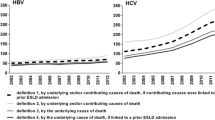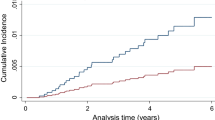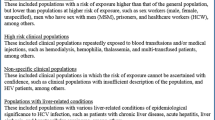Abstract
Hepatitis B (HBV) and C (HCV) viruses cause many liver diseases. To move beyond statistical interaction, we aimed to assess the coordinated effect of the two viruses on mortality using mediation analyses. A prospective cohort study of 3837 residents in Taiwan examined participants seropositive for hepatitis B, of which 181 subjects (4.7 %) were co-infected by HCV and 589 died during follow-up. Mediation analyses for cause-specific mortality were performed using Cox proportional hazards model. Follow-up HBV viral load was inversely correlated with baseline HCV viral load (r2 = −0.074; P < 0.001). For HCV serum viral load increasing from 800 to 404,000 IU/mL (minimum to median) at baseline, the effect of HCV mediated through HBV viral load decreased the all-cause mortality with a hazard ratio (HR) of 0.89 (95 % confidence interval (CI) 0.85, 0.94; P < 0.001), and the effect independent of HBV viral load had an opposite HR of 1.25 (95 % CI 0.98, 1.60; P = 0.08). The protective mediation effects of HCV viral load through HBV DNA level were observed in mortality from causes specific to liver-related diseases and liver cancer, but not in that from non-liver-related diseases. Our findings suggest a suppressive effect of HCV on mortality mediated through decreasing HBV viral load.

Similar content being viewed by others
References
Chen CJ, Yang HI, Su J, et al. Risk of hepatocellular carcinoma across a biological gradient of serum hepatitis B virus DNA level. JAMA. 2006;295(1):65–73. doi:10.1001/jama.295.1.65.
Oh JK, Shin HR, Lim MK, et al. Multiplicative synergistic risk of hepatocellular carcinoma development among hepatitis B and C co-infected subjects in HBV endemic area: a community-based cohort study. BMC Cancer. 2012;12:452. doi:10.1186/1471-2407-12-452.
(WHO) WHO http://www.euro.who.int/en/health-topics/communicable-diseases/hepatitis/data-and-statistics (2014)
Lee MH, Yang HI, Lu SN, et al. Chronic hepatitis C virus infection increases mortality from hepatic and extrahepatic diseases: a community-based long-term prospective study. J Infect Dis. 2012;206(4):469–77. doi:10.1093/infdis/jis385.
Giordano TP, Henderson L, Landgren O, et al. Risk of non-Hodgkin lymphoma and lymphoproliferative precursor diseases in US veterans with hepatitis C virus. JAMA. 2007;297(18):2010–7. doi:10.1001/jama.297.18.2010.
Chen CJ, Wang LY, Yu MW. Epidemiology of hepatitis B virus infection in the Asia-Pacific region. J Gastroenterol Hepatol. 2000;15(Suppl):E3–6.
Lu SN, Chue PY, Chen IL, et al. Incidence of hepatitis C infection in a hepatitis C endemic township in southern Taiwan. Kaohsiung J Med Sci. 1997;13(10):605–8.
Sun CA, Chen HC, Lu CF, et al. Transmission of hepatitis C virus in Taiwan: prevalence and risk factors based on a nationwide survey. J Med Virol. 1999;59(3):290–6.
Wu JS, Lu CF, Chou WH, et al. High prevalence of hepatitis C virus infection in aborigines in Taiwan. Jpn J Med Sci Biol. 1992;45(4):165–74.
Lu SN, Chen HC, Tang CM, et al. Prevalence and manifestations of hepatitis C seropositivity in children in an endemic area. Pediatr Infect Dis J. 1998;17(2):142–5.
Liu Z, Hou J. Hepatitis B virus (HBV) and hepatitis C virus (HCV) dual infection. Int J Med Sci. 2006;3(2):57–62.
Sun CA, Farzadegan H, You SL, et al. Mutual confounding and interactive effects between hepatitis C and hepatitis B viral infections in hepatocellular carcinogenesis: a population-based case-control study in Taiwan. Cancer Epidemiol Biomark Prev. 1996;5(3):173–8.
Shi J, Zhu L, Liu S, Xie WF. A meta-analysis of case-control studies on the combined effect of hepatitis B and C virus infections in causing hepatocellular carcinoma in China. Br J Cancer. 2005;92(3):607–12. doi:10.1038/sj.bjc.6602333.
Sun CA, Wu DM, Lin CC, et al. Incidence and cofactors of hepatitis C virus-related hepatocellular carcinoma: a prospective study of 12,008 men in Taiwan. Am J Epidemiol. 2003;157(8):674–82.
Huang YT, Jen CL, Yang HI, et al. Lifetime risk and sex difference of hepatocellular carcinoma among patients with chronic hepatitis B and C. J Clin Oncol. 2011;29(27):3643–50. doi:10.1200/JCO.2011.36.2335.
Kruse RL, Kramer JR, Tyson GL, et al. Clinical outcomes of hepatitis B virus coinfection in a United States cohort of hepatitis C virus-infected patients. Hepatology. 2014;60(6):1871–8. doi:10.1002/hep.27337.
Baron RM, Kenny DA. The moderator-mediator variable distinction in social psychological research: conceptual, strategic, and statistical considerations. J Pers Soc Psychol. 1986;51(6):1173–82.
MacKinnon DP. Introduction to statistical mediation analysis. New York: Lawrence Erlbaum Associates; 2008.
Robins JM, Greenland S. Identifiability and exchangeability for direct and indirect effects. Epidemiology. 1992;3(2):143–55.
VanderWeele TJ, Asomaning K, Tchetgen Tchetgen EJ, et al. Genetic variants on 15q25.1, smoking, and lung cancer: an assessment of mediation and interaction. Am J Epidemiol. 2012;175(10):1013–20. doi:10.1093/aje/kwr467.
Chen CL, Yang HI, Yang WS, et al. Metabolic factors and risk of hepatocellular carcinoma by chronic hepatitis B/C infection: a follow-up study in Taiwan. Gastroenterology. 2008;135(1):111–21. doi:10.1053/j.gastro.2008.03.073.
Iloeje UH, Yang HI, Jen CL, et al. Risk and predictors of mortality associated with chronic hepatitis B infection. Clin Gastroenterol Hepatol. 2007;5(8):921–31. doi:10.1016/j.cgh.2007.06.015.
Lee MH, Yang HI, Lu SN, et al. Hepatitis C virus seromarkers and subsequent risk of hepatocellular carcinoma: long-term predictors from a community-based cohort study. J Clin Oncol. 2010;28(30):4587–93. doi:10.1200/JCO.2010.29.1500.
Cox DR. Regression models and life-tables. J R Stat Soc B. 1972;34(2):187–220.
VanderWeele TJ. Causal mediation analysis with survival data. Epidemiology. 2011;22(4):582–5. doi:10.1097/EDE.0b013e31821db37e.
Vanderweele TJ, Vansteelandt S. Odds ratios for mediation analysis for a dichotomous outcome. Am J Epidemiol. 2010;172(12):1339–48. doi:10.1093/aje/kwq332.
Robins JM. Semantics of causal DAG models and the identification of direct and indirect effects. In: Geen P, Hjort NL, Richardson S, editors. New York: Oxford University Press; 2003
Tsiquaye KN, Portmann B, Tovey G, et al. Non-A, non-B hepatitis in persistent carriers of hepatitis B virus. J Med Virol. 1983;11(3):179–89.
Koike K, Yasuda K, Yotsuyanagi H, et al. Dominant replication of either virus in dual infection with hepatitis viruses B and C. J Med Virol. 1995;45(2):236–9.
Liaw YF. Role of hepatitis C virus in dual and triple hepatitis virus infection. Hepatology. 1995;22(4 Pt 1):1101–8.
Shih CM, Lo SJ, Miyamura T, Chen SY, Lee YH. Suppression of hepatitis B virus expression and replication by hepatitis C virus core protein in HuH-7 cells. J Virol. 1993;67(10):5823–32.
Schuttler CG, Fiedler N, Schmidt K, Repp R, Gerlich WH, Schaefer S. Suppression of hepatitis B virus enhancer 1 and 2 by hepatitis C virus core protein. J Hepatol. 2002;37(6):855–62.
Bellecave P, Gouttenoire J, Gajer M, et al. Hepatitis B and C virus coinfection: a novel model system reveals the absence of direct viral interference. Hepatology. 2009;50(1):46–55. doi:10.1002/hep.22951.
Acknowledgments
NIH/NCI R03 CA182937-02, NIH/NIA R01 AG048825-01 and Salomon Research Fund at Brown University.
Author information
Authors and Affiliations
Corresponding author
Electronic supplementary material
Below is the link to the electronic supplementary material.
Rights and permissions
About this article
Cite this article
Huang, YT., Freeman, J.R., Yang, HI. et al. Mediation effect of hepatitis B and C on mortality. Eur J Epidemiol 31, 625–633 (2016). https://doi.org/10.1007/s10654-016-0118-x
Received:
Accepted:
Published:
Issue Date:
DOI: https://doi.org/10.1007/s10654-016-0118-x




